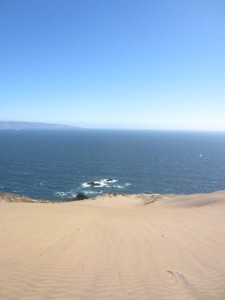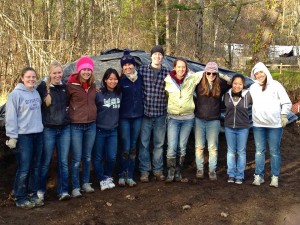I was playing frisbee in a park, the wind strong enough that it kept blowing the disc into the building which once served as a powder keg. We started to notice the plumes of smoke as we were walking down the hill, but it was not the first time I have seen smoke rise from the hills here. The view of black and red rising over the cemetery was picturesque, nothing else.
We had a barbecue planned, with a mixture of Chileans and Americans, and we kept stoking our little fire as the big one raged, drinking our wine and worrying but not having anything else to do. The firefighters here are volunteers and it is hard to get fire trucks up the hills in an efficient manner. The winds remained high, spreading what started as a forest fire to the outskirts of the city. These high parts of the city are populated by folks who put up their wood and tin houses on property they have no legal rights to, and the fire spread down into other houses as well, so that it seems everyone knows someone who knows someone who lost everything.
We couldn’t do anything else but watch as the smoke blurred our view of the stars and look at the apocalyptic shots of flames on the news. A state of emergency was called. We went home to sleep and in the morning to wake and see how we could help.
This city has seen many disasters, fires and earthquakes, and there is thankfully a generous response from all the people. “Fuerza Valpo” is soaped onto the rear windshield of taxis, the shelters are overflowing with clothes, and the streets that we walked up to help out had many others carrying up large bottles of water and packages of toilet paper. The hill goes up and up and eventually I remember seeing burned houses in the distance and I thought we still had some distance to go, but around the next corner there were suddenly buildings completely destroyed. It made me dizzy, seeing untouched houses next to broken down walls and ashes, seeing the flowers that grew outside survive while nothing else did, seeing people resolutely going upwards to help, and seeing people hugging one another as they came to terms with what had happened.
There was a man on the street dressed in clothes that marked him as a member of some church organization, carrying a clipboard and talking on his phone. He was asking the people around him what the name of the street was but nobody knew. Cesar, the Chilean I was with, told him to use the name of the school we were by as a reference, but even though the sign was right there the guy didn’t understand. A passerby asked if he was “half-gringo or something” that he should fail to understand, and Cesar said no, maybe Argentine. Someone else told us he was in fact from Uruguay, which all present understood to mean, he doesn’t speak our language.
As we got up further a journalist tried to stop us and interview us, as we were clearly a group of mostly foreigners. One girl from our group stopped to talk to him, although he was asking questions like why we were going to help, when that seemed self-explanatory, and whether people seemed receptive to us helping or whether there were tensions. It was so silly to the majority of us, since all we had done up to that point was walk up a hill, and our stories did not matter in comparison to the stories of people who lived there and people who were already actively engaged in helping. But because we were foreigners they followed us asking questions and taking photos when we took up shovels and started to work. We were helping at the house of a relative of a friend, moving all the rubble into empty pet food bags to be wheelbarrowed down the hill. We had also brought sandwiches and water to distribute, but there turned out to be many people walking around with these things, and with masks. When we got to the point where what remained was too hot to be shoveled, besides which there was a growing amount of smoke in the air, we headed back down the hill to see if any of the distribution centers needed help. After not finding any, we took the metro back to Viña, where sat tiredly, ash raining into the foam of our pitchers of beer.
This is my first time being in a disaster area. Normally I feel so helpless when something happens in another part of the world, and now I am in that part of the world. It still is not easy to know what type of help is most needed, but with over 2000 houses burned (the most recent figure I have heard) I know that they will continue needing help for quite some time, and it is important to pace myself and not feel too frustrated if I can’t do everything at once. I don’t mean to only write about earthquakes and fires, but for now this is what occupies my thoughts.
Fuerza Valpo.


